It looks like you're using an Ad Blocker.
Please white-list or disable AboveTopSecret.com in your ad-blocking tool.
Thank you.
Some features of ATS will be disabled while you continue to use an ad-blocker.
share:
a reply to: Astronomer62
The image from Cuba of the underwater complex looks very similar to other megalithics found world wide. Of particular note the off set of the pyramid (orion)
I will try and load the image morrow. The upload is a bit slow atm.
archaeology-world.com...
The image from Cuba of the underwater complex looks very similar to other megalithics found world wide. Of particular note the off set of the pyramid (orion)
I will try and load the image morrow. The upload is a bit slow atm.
archaeology-world.com...
a reply to: purplemer
You did ask about the Julian Calendar and Sirius previously, there was a time when Sirius hardly moved, using the calendar for over 2,000 years, i can't explain that at all as it only happened in area around Cairo????
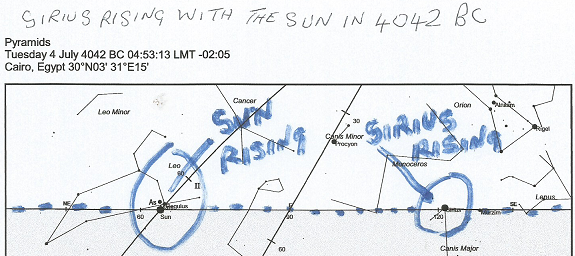
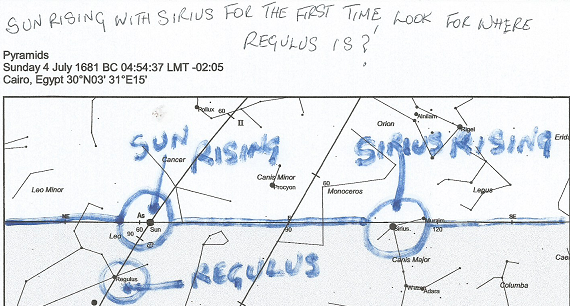
Perhaps Tesla had the right idea about the location of the Pyramids?
www.youtube.com...
You did ask about the Julian Calendar and Sirius previously, there was a time when Sirius hardly moved, using the calendar for over 2,000 years, i can't explain that at all as it only happened in area around Cairo????


Perhaps Tesla had the right idea about the location of the Pyramids?
www.youtube.com...
a reply to: Astronomer62
I can't get my head around this at all. Just to be clear according to the modelling software this alignment was consistent everyday for 2000 years? Are you able to find other similar occurrences with any other stars at different co-ordinates? I know its a needle in a haystack but surely this isn't an isolated anomaly?
I can't get my head around this at all. Just to be clear according to the modelling software this alignment was consistent everyday for 2000 years? Are you able to find other similar occurrences with any other stars at different co-ordinates? I know its a needle in a haystack but surely this isn't an isolated anomaly?
a reply to: Astronomer62
Similar, but not exactly. In the year 67,000 AD, Sirius will be the South Pole Star. It moves.
Sirius
Other proper motions demonstrated:
orbitsimulator.com...
For example:
No. Try this location: +35º, -150º. On July 8. Due to precession, longitude (depending on how precise you want to be), and latitude, the dates will be different but it happens all over the planet.
i can't explain that at all as it only happened in area around Cairo????
www.universeguide.com...
The star is moving -1,223.10 milliarcseconds/year towards the north and -546.00 milliarcseconds/year east if we saw them in the horizon. .
Similar, but not exactly. In the year 67,000 AD, Sirius will be the South Pole Star. It moves.
Sirius
Other proper motions demonstrated:
orbitsimulator.com...
For example:
edit on 8/31/2020 by Phage because: (no reason given)
a reply to: Phage
Hi Phage,
when using a back dated Julian Calendar that started on 1st January 0045 BC, i found in Cairo that it did correspond to 4th July between 4042 BC to 1681 BC, part of the reason can be found below:-
The Sothic year is the interval between heliacal risings of the star Sirius. Its duration is very close to the mean Julian year of 365.25 days.
academickids.com...
Be sure you are using a Proleptic Julian Calendar when researching:-
en.wikipedia.org...
If you use the Proleptic Gregorian Calendar, it will not give the same results:-
en.wikipedia.org...
I'm using two degrees measure (one degree either way of curve), with curve of the Earth, but during this period as yet, i haven't found another area where the Sun and Sirius were rising on any day for as long as this.
I was wondering if in very ancient times before recorded history, if ancient people had discovered the basis of the Julian Calendar, and used Sirius as a bench mark for a year before the Egyptians?
Some might say that the Sun is twinned with Sirius!
Hi Phage,
when using a back dated Julian Calendar that started on 1st January 0045 BC, i found in Cairo that it did correspond to 4th July between 4042 BC to 1681 BC, part of the reason can be found below:-
The Sothic year is the interval between heliacal risings of the star Sirius. Its duration is very close to the mean Julian year of 365.25 days.
academickids.com...
Be sure you are using a Proleptic Julian Calendar when researching:-
en.wikipedia.org...
If you use the Proleptic Gregorian Calendar, it will not give the same results:-
en.wikipedia.org...
I'm using two degrees measure (one degree either way of curve), with curve of the Earth, but during this period as yet, i haven't found another area where the Sun and Sirius were rising on any day for as long as this.
I was wondering if in very ancient times before recorded history, if ancient people had discovered the basis of the Julian Calendar, and used Sirius as a bench mark for a year before the Egyptians?
Some might say that the Sun is twinned with Sirius!
edit on 2-9-2020 by Astronomer62 because: Edit.
originally posted by: Grenade
a reply to: Astronomer62
I can't get my head around this at all. Just to be clear according to the modelling software this alignment was consistent everyday for 2000 years? Are you able to find other similar occurrences with any other stars at different co-ordinates? I know its a needle in a haystack but surely this isn't an isolated anomaly?
Hi Grenade,
Sirius only rose with Sirius on 4th July between 4042 BC and 1681 BC In Cairo but using the backdated Julian Calendar, the reason is that the Julian Calendar is very close to a "Sirius Cycle" of 365.25 days, but other stars are subject to precession.
The dates at the beginning being in 1681 BC and the later 4042 BC are staggered at the ends and don't turn up every year, because the leap year day is only added every 4 years so some years then fall outside the one degree margin each side of the curve of the Earth.
I'm using two degrees measure (one degree either way of curve), with curve of the Earth, but during this period as yet, i haven't found another area where the Sun and Sirius were rising on any day for as long as this.
Then you didn't look very hard.
Sunrise at 35ºN, 150ºE
4042 BC
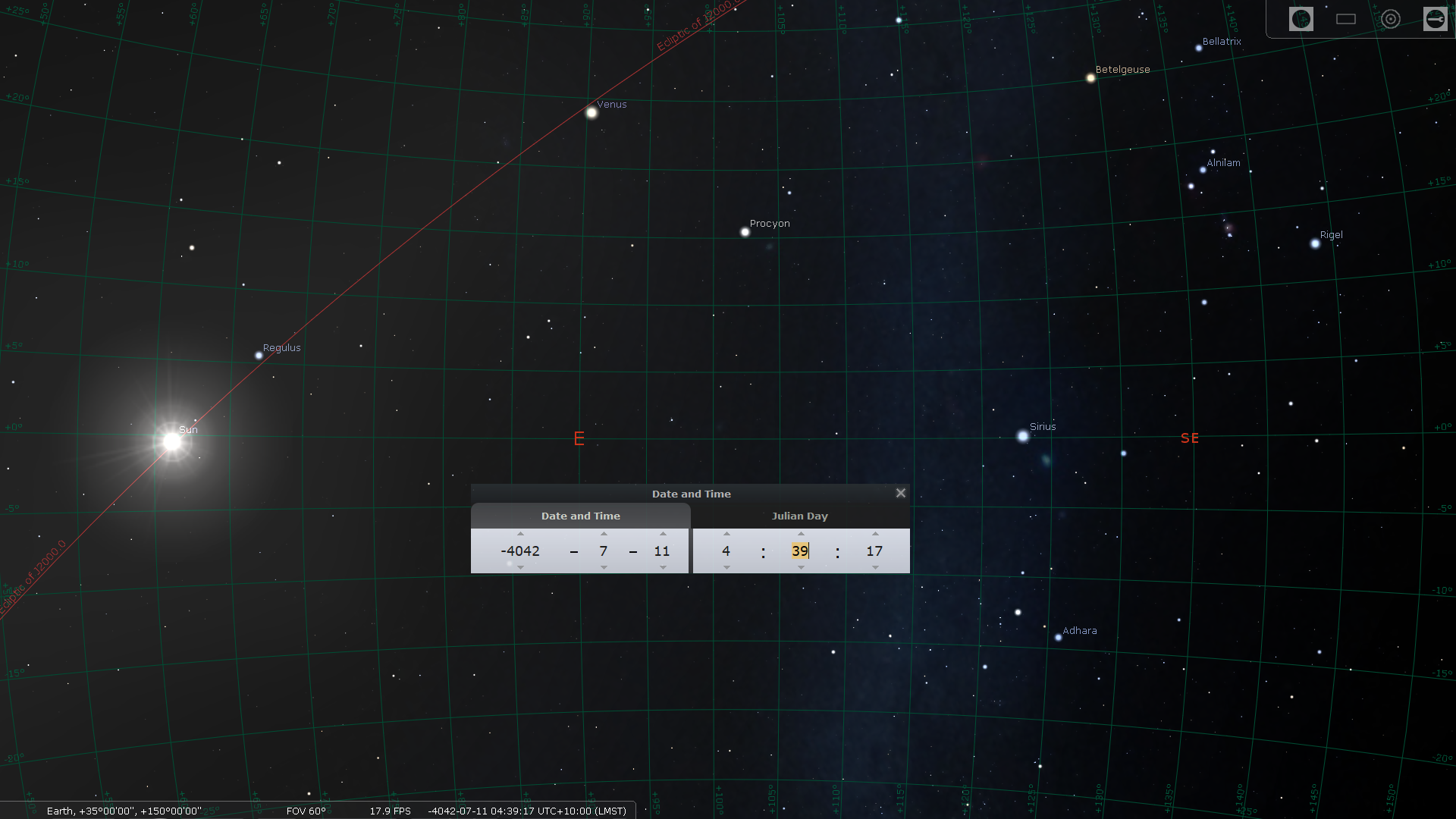
1681 BC

You can right click to view full sized.
All stars are "subject" to precession. All stars also have proper motion of their own.
but other stars are subject to precession.
They would be in error.
Some might say that the Sun is twinned with Sirius!
edit on 9/2/2020 by Phage because: (no reason given)
Why is this such a hot topic? It doesn't even have aliens in it.
edit on 3-9-2020 by whereislogic because: (no reason given)
originally posted by: Phage
I'm using two degrees measure (one degree either way of curve), with curve of the Earth, but during this period as yet, i haven't found another area where the Sun and Sirius were rising on any day for as long as this.
Then you didn't look very hard.
Sunrise at 35ºN, 150ºE
4042 BC
1681 BC
You can right click to view full sized.
All stars are "subject" to precession. All stars also have proper motion of their own.
but other stars are subject to precession.
They would be in error.
Some might say that the Sun is twinned with Sirius!
Hi Phage,
I thought to start, i would post diagram below:-
www.physics.unlv.edu...
Isaac Newton (1642 – 1726/27 ) determined the cause of precession and established the rate of precession at 1 degree per 72 years, very close to the best value measured today, thus demonstrating the magnitude of the error in the earlier value of 1 degree per century.
Scroll down to bottom of link:-
en.wikipedia.org...
But this was for the Gregorian Calendar that was established in 1582, it is probably longer for the Julian Calendar, however the two astronomy pictures you posted again shows that Sirius was within one degree of horizon (either way) as the Sun was half way on horizon.
When you enlarge your pictures again and look at the red line of the ecliptic, you will see that that Regulus is below horizon in year 1681 BC, but is subject to precession, because Regulus is above horizon in 4042 BC.
However by the two degree process, Sirius is still the heliacal rising star, even for the Julian Calendar this is startling for Sirius to remain in place for over 2,300 years, against precession.
I have to admit that i hadn't researched much regarding other area's where this took place, along the 35th parellel North, however you are correct that it did happen there, i found it in Saveh, Iran:-
en.wikipedia.org...
But my time has been spent trying to find a larger period when Sirius was the Heliacal rising star, and i have just found one in Rome, Italy, it is interrupted and finishes in 1581, i had to for in 1582, the new Gregorian Calendar was adopted, but am confident that it would have continued for over 4,500 years if this had not taken place.
One degree is four minutes of time, and i have been careful charting this from 3805 BC, Regulus shows the same precession, you will see this but it doesn't effect Sirius in the same way.
It must be noted in 238 BC by the Decree of Canopus that the Ptolemaic rulers of Egypt did try to add a leap year to every fourth year, which would have been in error of a true year by approx 11 minutes. I wonder if another more ancient civilization had used this method in aligning Sirius, that we don't know about?
en.wikipedia.org...
It would seem Sirius is strange by the effects of precession using the Julian Calendar and some would say as a year marker it was twinned with the Sun for far longer than Precession dictates by one degree every 72 years.
Below are the pictures for Rome, Sirius does get staggered and does dwindle out of one degree above or below horizon at the end being 20th July 3805 BC when Sirius is 3 minutes 59 seconds below horizon, being one second before one degree.
It continues up to 1581 AD when it stops abruptly by the Gregorian Calendar being adopted in 1582, but the alignment could have continued for at least another 3 hundred years so approx. 5,500 years!
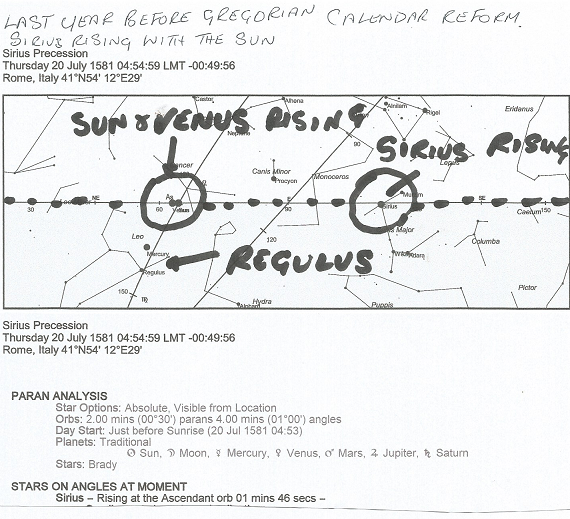
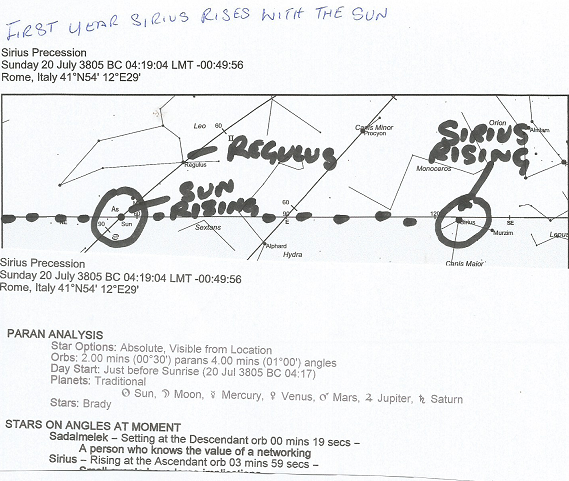
edit on 4-9-2020 by Astronomer62 because: Edit,
a reply to: Astronomer62
Sirius RA/Dec
7/4/4042 BC - 2h21'29.70"/-26º22'53.8"
7/4/1681 BC - 4h03'40.07"/-18º28'22.7"
7/4/2020 CE - 6h46'03.92"/-16º44'47.0"
It happens at any latitude, just on a different day.
I have to admit that i hadn't researched much regarding other area's where this took place, along the 35th parellel North, however you are correct that it did happen there, i found it in Saveh, Iran:-
Only because you are obsessed with one event. Sirius is affected by precession.
It would seem Sirius is strange by the effects of precession using the Julian Calendar and some would say as a year marker it was twinned with the Sun for far longer than Precession dictates by one degree every 72 years.
Sirius RA/Dec
7/4/4042 BC - 2h21'29.70"/-26º22'53.8"
7/4/1681 BC - 4h03'40.07"/-18º28'22.7"
7/4/2020 CE - 6h46'03.92"/-16º44'47.0"
edit on 9/4/2020 by Phage because: (no reason given)
Sothic cycles can possibly resolve this.
And I really don't need any non-wikipedia input of my own.
And
And also:
And I really don't need any non-wikipedia input of my own.
The Sothic cycle or Canicular period is a period of 1,461 Egyptian civil years of 365 days each or 1,460 Julian years averaging 365¼ days each. During a Sothic cycle, the 365-day year loses enough time that the start of its year once again coincides with the heliacal rising of the star Sirius
And
The ancient Egyptian civil year, its holidays, and religious records reflect its apparent establishment at a point when the return of the bright star Sirius to the night sky was considered to herald the annual flooding of the Nile. However, because the civil calendar was exactly 365 days long and did not incorporate leap years until 22 BC, its months "wandered" backwards through the solar year at the rate of about one day in every four years. This almost exactly corresponded to its displacement against the Sothic year as well. (The Sothic year is about a minute longer than a Julian year.) The sidereal year of 365.25636 days is only valid for stars on the ecliptic (the apparent path of the Sun across the sky), whereas Sirius's displacement ~40° below the ecliptic, its proper motion, and the wobbling of the celestial equator cause the period between its heliacal risings to be almost exactly 365.25 days long instead. This steady loss of one relative day every four years over the course of the 365-day calendar meant that the "wandering" day would return to its original place relative to the solar and Sothic year after precisely 1461 civil or 1460 Julian years.
And also:
The Sothic year is remarkable because its average duration was exactly 365.25 days in the early 4th millennium BC before the unification of Egypt. The slow rate of change from this value is also of note. If observations and records could have been maintained during predynastic times the Sothic rise would optimally return to the same calendar day after 1461 calendar years. This value would drop to about 1456 calendar years by the Middle Kingdom. The 1461 value could also be maintained if the date of the Sothic rise were artificially maintained by moving the feast in celebration of this event one day every fourth year instead of rarely adjusting it according to observation.
It has been noticed, and the Sothic cycle confirms, that Sirius does not move retrograde across the sky like other stars, a phenomenon widely known as the precession of the equinox. Professor Jed Buchwald wrote "Sirius remains about the same distance from the equinoxes—and so from the solstices—throughout these many centuries, despite precession." [11] For the same reason, the heliacal rising or zenith of Sirius does not slip through the calendar at the precession rate of about one day per 71.6 years as other stars do but much slower. This remarkable stability within the solar year may be one reason that the Egyptians used it as a basis for their calendar. The coincidence of a heliacal rising of Sirius and the New Year reported by Censorinus occurred about the 20th of July, that is a month later after the summer solstice.
edit on 4-9-2020 by
Degradation33 because: (no reason given)
a reply to: Astronomer62
I took some time to write a script for Stellarium. Here are the tracks of some stars from 8,800 BC through 1,500 CE, in 100 year increments.
While it is true that during the time period you are obsessed with the date of the heliacal rising of Sirius was quite consistant, it can be seen that is because the elevation of Sirius was at a cusp in relation to the Sun. Sirius was making the transition from rising higher in the sky to falling lower, while still moving toward the ecliptic under the effects of precession. Fortuitous for the Egyptians, it made their calendar pretty accurate for a long while.
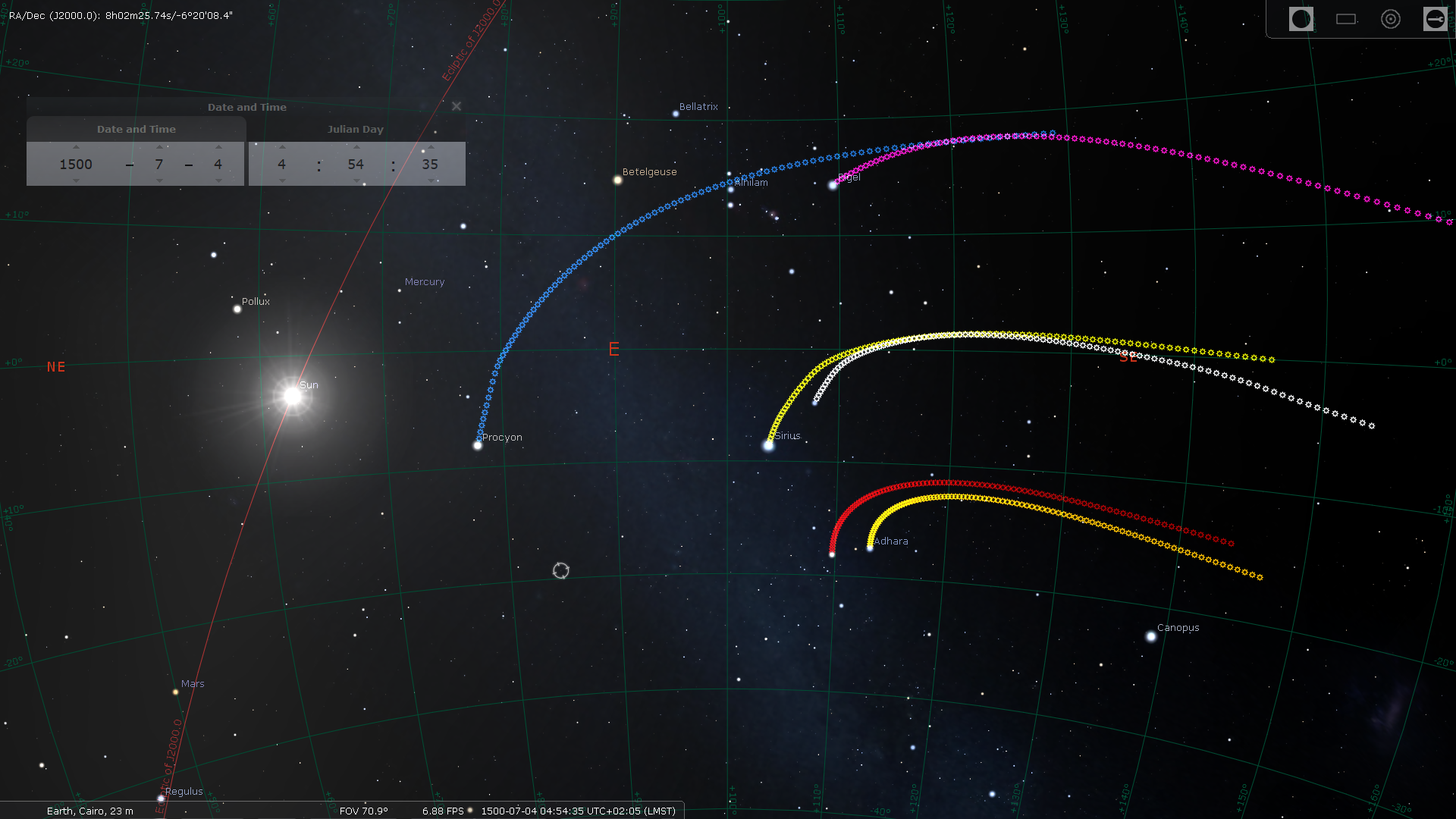
That flattening is interesting. Precession alone should result in nearly circular arcs (with some variation due to proper motion). Perhaps there was a convergence of orbital and axial factors at that time or perhaps it is due to errors from looking too far back. In regard to the latter, the configurations provided by Stellarium match yours for specific dates so if the problem is with the calculations, we share them. Perhaps you might undertake to duplicate my efforts.
It is quite clear however, that the position of Sirius is affected by precession, as is that of the other stars.
I took some time to write a script for Stellarium. Here are the tracks of some stars from 8,800 BC through 1,500 CE, in 100 year increments.
While it is true that during the time period you are obsessed with the date of the heliacal rising of Sirius was quite consistant, it can be seen that is because the elevation of Sirius was at a cusp in relation to the Sun. Sirius was making the transition from rising higher in the sky to falling lower, while still moving toward the ecliptic under the effects of precession. Fortuitous for the Egyptians, it made their calendar pretty accurate for a long while.

That flattening is interesting. Precession alone should result in nearly circular arcs (with some variation due to proper motion). Perhaps there was a convergence of orbital and axial factors at that time or perhaps it is due to errors from looking too far back. In regard to the latter, the configurations provided by Stellarium match yours for specific dates so if the problem is with the calculations, we share them. Perhaps you might undertake to duplicate my efforts.
It is quite clear however, that the position of Sirius is affected by precession, as is that of the other stars.
edit on 9/5/2020 by Phage because: (no reason given)
a reply to: Phage
Hi Phage,
Thank you for your reply, obviously i knew that Sirius rising with the Sun happens on many latitudes, but these cycles can be of different lengths of time using a measure of Sirius being above or below the horizon by one degree being 4 minutes of time, if we to look at Thebes on 31st December during the period 0490 BC to 0616 AD we find it only lasts just over 1,100 years, so these cycles can have different time frames.
This is important to me, because i'm searching for a latitude where calendars were first thought of regarding Sirius, which could give us a clue to location, as it wasn't Egypt.
There is a great deal wrong with the assumption that the Sothic Cycle started in Egypt, indeed i cant understand how any could think so, who study astronomy, as this effects chronology of Egyptian history, and puts much in doubt, indeed i have written about this before:-
en.wikipedia.org...
www.abovetopsecret.com...
It was Censorinus, a Roman astronomer who first recorded that The heliacal rising of Sirius, being 20th July 0139 AD, being 1st of Thoth and Egyptian New Year, but history is written by the victors not the defeated, so he was looking in Rome where a Cosmic alignment was happening, meaning both Sirius and the Sun was on the horizon, but you couldn't see it, as the Sun would have been too bright.
It was the Greek astrologers and astronomers that could record this by math and geometry, before then the Sun had to be below the horizon with Sirius slightly above horizon, therefore the Egyptians waited for the first yellow tinge in the East, while they could still see Sirius.
However you look at this, it didn't happen in Egypt, the Sun is approx. 12 degrees below horizon as Sirius rose, i have gone all the way from Aswan to Alexandria, and the Sun is well below the horizon when Sirius rose along the Nile.
Even if we go back to the Sothic Cycle before on 19th July 2781, it still doesn't link up, but it is "THE 19th JULY" that i'm most interested in.
Could the date have been symbolic, could the date have been taught by another earlier culture?
In England we have had a few symbolic dates for New Year, one was Christmas Day, the other was 25th March, when we were following the Julian Calendar. The reason was after the Gregorian Reform of 1582 in Rome, only ten days were taken out, as they didn't reform the whole Julian Calendar of errors but stopped at the First Council of Nicaea in 325 AD, so didn't go back to 1st January 0045 BC when the Julian Calendar started, this means that the Vernal Equinox would have been 25th March and the Winter Solstice would have fallen on 25th December.
So there is so much regarding symbolism that could have been taught to the Egyptians regarding dates from an earlier culture that lived at a different latitude, which is why i'm interested in 19th July going backwards.
Astronomy pictures below regarding Sothic Cycle in Egypt, i'll be back soon:-
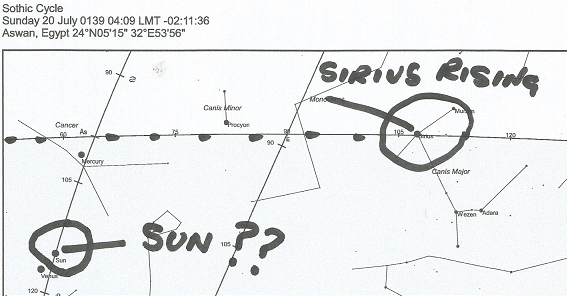
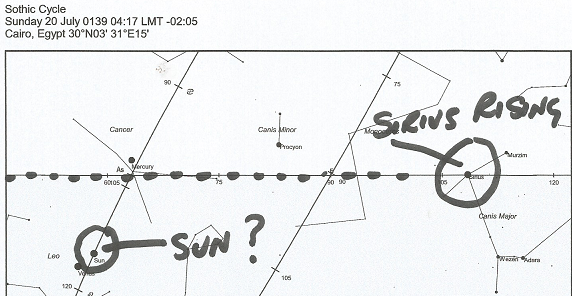
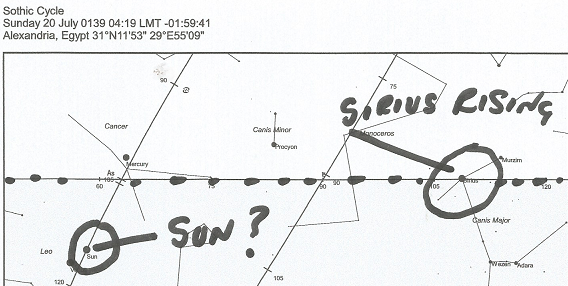
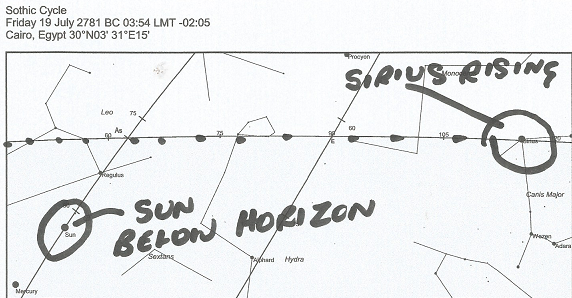
Hi Phage,
Thank you for your reply, obviously i knew that Sirius rising with the Sun happens on many latitudes, but these cycles can be of different lengths of time using a measure of Sirius being above or below the horizon by one degree being 4 minutes of time, if we to look at Thebes on 31st December during the period 0490 BC to 0616 AD we find it only lasts just over 1,100 years, so these cycles can have different time frames.
This is important to me, because i'm searching for a latitude where calendars were first thought of regarding Sirius, which could give us a clue to location, as it wasn't Egypt.
There is a great deal wrong with the assumption that the Sothic Cycle started in Egypt, indeed i cant understand how any could think so, who study astronomy, as this effects chronology of Egyptian history, and puts much in doubt, indeed i have written about this before:-
en.wikipedia.org...
www.abovetopsecret.com...
It was Censorinus, a Roman astronomer who first recorded that The heliacal rising of Sirius, being 20th July 0139 AD, being 1st of Thoth and Egyptian New Year, but history is written by the victors not the defeated, so he was looking in Rome where a Cosmic alignment was happening, meaning both Sirius and the Sun was on the horizon, but you couldn't see it, as the Sun would have been too bright.
It was the Greek astrologers and astronomers that could record this by math and geometry, before then the Sun had to be below the horizon with Sirius slightly above horizon, therefore the Egyptians waited for the first yellow tinge in the East, while they could still see Sirius.
However you look at this, it didn't happen in Egypt, the Sun is approx. 12 degrees below horizon as Sirius rose, i have gone all the way from Aswan to Alexandria, and the Sun is well below the horizon when Sirius rose along the Nile.
Even if we go back to the Sothic Cycle before on 19th July 2781, it still doesn't link up, but it is "THE 19th JULY" that i'm most interested in.
Could the date have been symbolic, could the date have been taught by another earlier culture?
In England we have had a few symbolic dates for New Year, one was Christmas Day, the other was 25th March, when we were following the Julian Calendar. The reason was after the Gregorian Reform of 1582 in Rome, only ten days were taken out, as they didn't reform the whole Julian Calendar of errors but stopped at the First Council of Nicaea in 325 AD, so didn't go back to 1st January 0045 BC when the Julian Calendar started, this means that the Vernal Equinox would have been 25th March and the Winter Solstice would have fallen on 25th December.
So there is so much regarding symbolism that could have been taught to the Egyptians regarding dates from an earlier culture that lived at a different latitude, which is why i'm interested in 19th July going backwards.
Astronomy pictures below regarding Sothic Cycle in Egypt, i'll be back soon:-




edit on 6-9-2020 by Astronomer62 because: Error.
Hi Phage,
I'm repeating the paragraph below to add pictures of astronomy.
Thank you for your reply, obviously i knew that Sirius rising with the Sun happens on many latitudes, but these cycles can be of different lengths of time using a measure of Sirius being above or below the horizon by one degree being 4 minutes of time, if we to look at Thebes on 31st December during the period 0490 BC to 0616 AD we find it only lasts just over 1,100 years, so these cycles can have different time frames, the one below is Sirius rising as Sun sets.
The Ancient Greeks used sunset previous to date as the start of the day and as Cleopatra was a Ptolemaic ruler, she used that date for as the Sun set on 31st December 0046 BC, the next day was 1st January 0045BC, the start of the Julian Calendar in Thebes, now Luxor, it was probably intentional:-
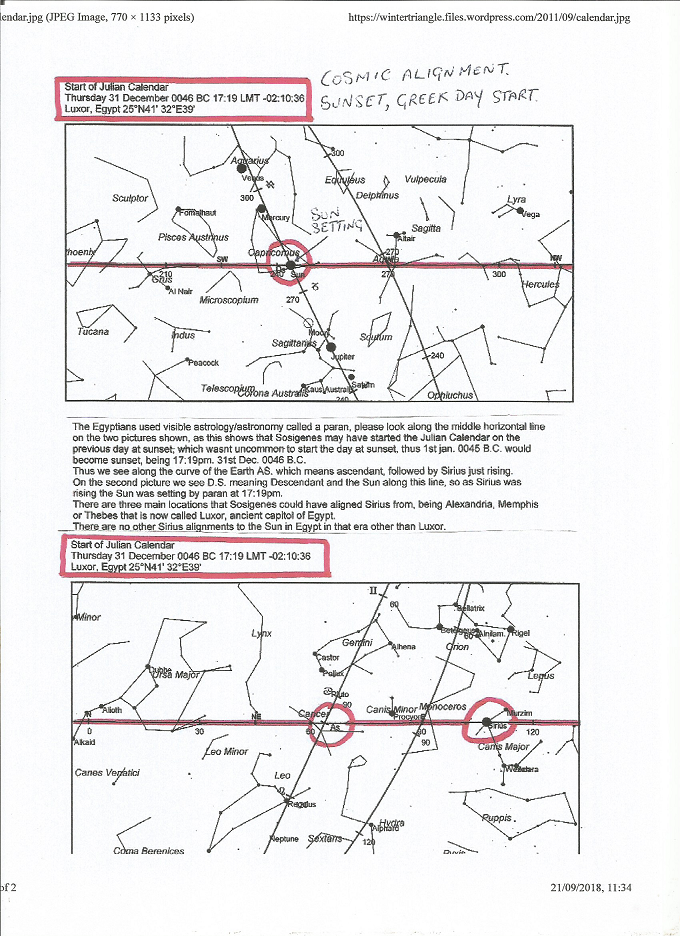

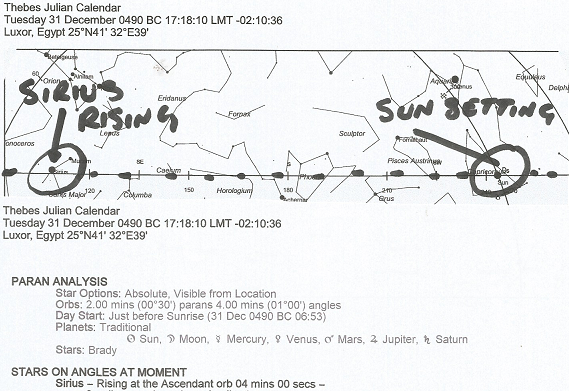
I'm repeating the paragraph below to add pictures of astronomy.
Thank you for your reply, obviously i knew that Sirius rising with the Sun happens on many latitudes, but these cycles can be of different lengths of time using a measure of Sirius being above or below the horizon by one degree being 4 minutes of time, if we to look at Thebes on 31st December during the period 0490 BC to 0616 AD we find it only lasts just over 1,100 years, so these cycles can have different time frames, the one below is Sirius rising as Sun sets.
The Ancient Greeks used sunset previous to date as the start of the day and as Cleopatra was a Ptolemaic ruler, she used that date for as the Sun set on 31st December 0046 BC, the next day was 1st January 0045BC, the start of the Julian Calendar in Thebes, now Luxor, it was probably intentional:-



edit on 6-9-2020 by Astronomer62 because: Error.
To find out where the Ancient Egyptians got the Symbolic dates from for the Sothic Cycle, we have a clue as a "Cosmic Alignment" that lasted Approx.
5,500 years was happening in Rome during that time, but it wasn't Rome, without the Greeks with their math and astronomy/astrology, it wouldn't be
seen, they were able to plot it on astrology charts.
So where did the Egyptians get the symbolic dates of 19th/20th July from that appear in the Sothic Cycle? This is where an Archaeoastromer can help, it would have to be at a latitude where the Sun was just below the horizon and Sirius was just above horizon, no Greeks to help, beyond the Egyptians, so this needs to be visible, so we are looking for Sun below horizon, just being able to see a yellow tinge in the East without the sky being so bright that you can't see Sirius just above horizon,
It means we have to drop several degrees of latitude from Rome at approx. 42 degrees, i think it was along the 37th parallel, link below:-
en.wikipedia.org...
The city of Sanliurfa, Turkey is along that line, which is within 7 miles of Gobekli Tepe which i have used as a fix, that many think is as old as the 10th Millennium BC.
The astronomy there for 19th July is correct for ancient sky watchers as far as i can tell as my astronomy programme only goes back to 5,399 BC, perhaps Phage will help with going back to at least 8,000 BC to look at this with the Sun below horizon and Sirius above horizon? I have tracked it from 1582 AD to 5,399 BC, shown later in report.
en.wikipedia.org...
All this would verify link below:-
www.newscientist.com...
From here the trail goes cold, the culture of Gobekli Tepe may have discovered the Sothic Cycle or they were told about it from an earlier culture, all i can say is "Non Plus Ultra" associated with the Pillars of Hercules, being one degree down from Gobekli Tepe at 36 degrees Latitude:-
en.wikipedia.org...
I hope in my life time they can excavate and date structure below under approx. 2 thousand feet of water by robot subs, near Cuba.

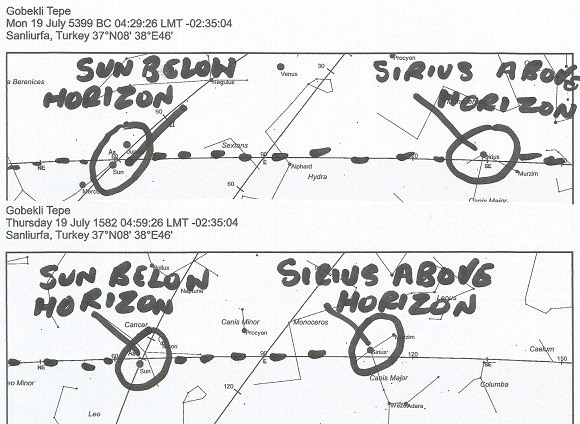
So where did the Egyptians get the symbolic dates of 19th/20th July from that appear in the Sothic Cycle? This is where an Archaeoastromer can help, it would have to be at a latitude where the Sun was just below the horizon and Sirius was just above horizon, no Greeks to help, beyond the Egyptians, so this needs to be visible, so we are looking for Sun below horizon, just being able to see a yellow tinge in the East without the sky being so bright that you can't see Sirius just above horizon,
It means we have to drop several degrees of latitude from Rome at approx. 42 degrees, i think it was along the 37th parallel, link below:-
en.wikipedia.org...
The city of Sanliurfa, Turkey is along that line, which is within 7 miles of Gobekli Tepe which i have used as a fix, that many think is as old as the 10th Millennium BC.
The astronomy there for 19th July is correct for ancient sky watchers as far as i can tell as my astronomy programme only goes back to 5,399 BC, perhaps Phage will help with going back to at least 8,000 BC to look at this with the Sun below horizon and Sirius above horizon? I have tracked it from 1582 AD to 5,399 BC, shown later in report.
en.wikipedia.org...
All this would verify link below:-
www.newscientist.com...
From here the trail goes cold, the culture of Gobekli Tepe may have discovered the Sothic Cycle or they were told about it from an earlier culture, all i can say is "Non Plus Ultra" associated with the Pillars of Hercules, being one degree down from Gobekli Tepe at 36 degrees Latitude:-
en.wikipedia.org...
I hope in my life time they can excavate and date structure below under approx. 2 thousand feet of water by robot subs, near Cuba.


a reply to: Astronomer62
Thank you for posts. Thought would share this with you. (Its i think it was along the 37th parallel. The line you where after.
Sirius: The Star of the Maltese Temples | Lenie Reedijk | Origins Conference
Its a good watch. Shows the sites of the megalithic isles of Matla. Lenie Reedijk has lined the many (I think 66) temple entrances up with the movement of Sirius after it started rising about 9000bc The entrances all line up with the rise of only one star and thats the star sirius. The array of entrances orientations to the temple cannot line up with any other star nor the sun or moon. Interestingly enough if this is the case and it looks like it would knock the dates of the temples back and that wouldn't surprise me.
Of note the oldest temple was the one that lined up with Sirius rising as it rose for the first time. This gives further credence to this theory.
Below are some images of the temples and the last image shows the orientation of the entrances.


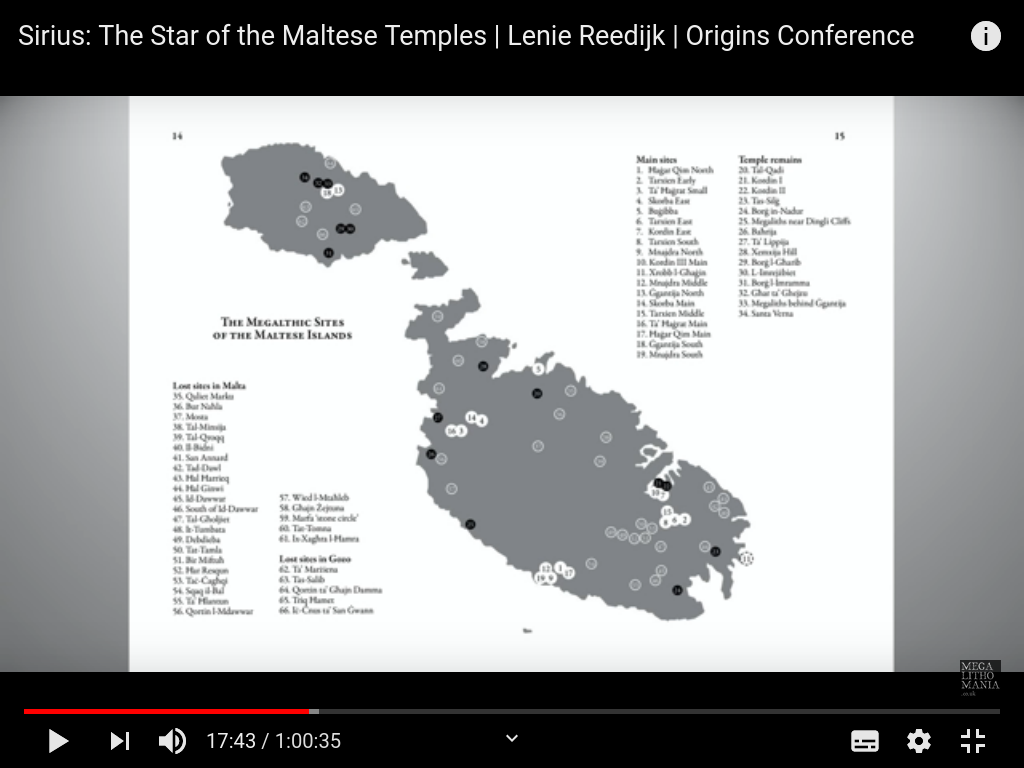
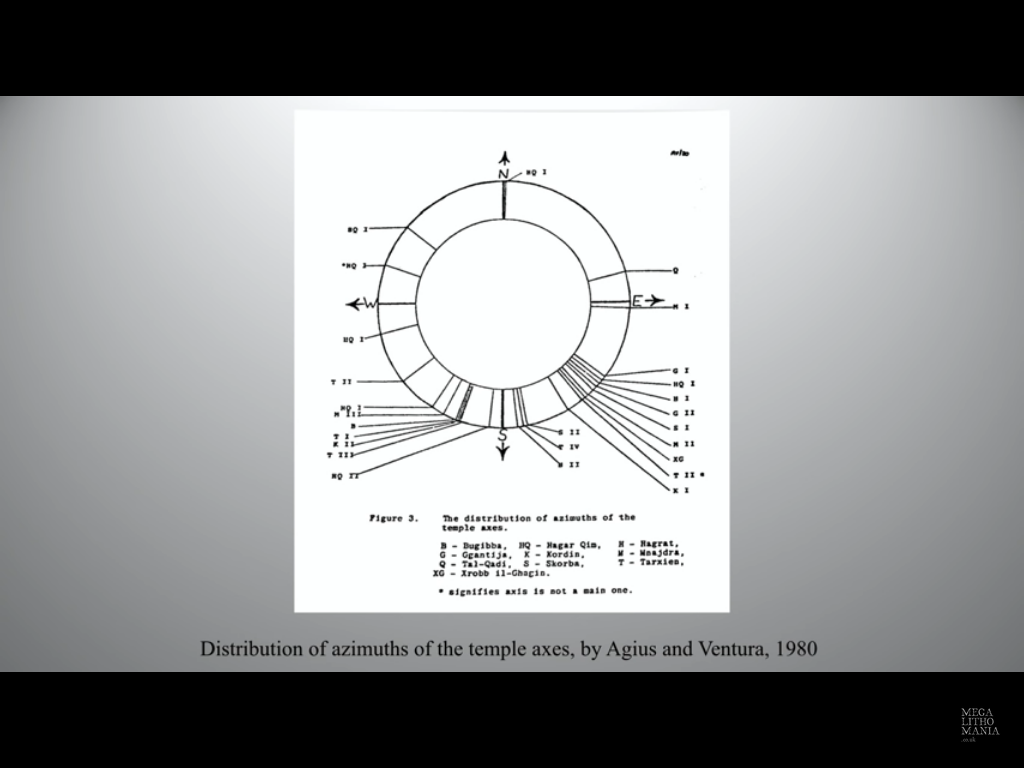
Happy days :-)
Thank you for posts. Thought would share this with you. (Its i think it was along the 37th parallel. The line you where after.
Sirius: The Star of the Maltese Temples | Lenie Reedijk | Origins Conference
Its a good watch. Shows the sites of the megalithic isles of Matla. Lenie Reedijk has lined the many (I think 66) temple entrances up with the movement of Sirius after it started rising about 9000bc The entrances all line up with the rise of only one star and thats the star sirius. The array of entrances orientations to the temple cannot line up with any other star nor the sun or moon. Interestingly enough if this is the case and it looks like it would knock the dates of the temples back and that wouldn't surprise me.
Of note the oldest temple was the one that lined up with Sirius rising as it rose for the first time. This gives further credence to this theory.
Below are some images of the temples and the last image shows the orientation of the entrances.




Happy days :-)
edit on 6-9-2020 by purplemer because: (no reason given)
a reply to: Astronomer62
I am very intrested in any knowledge you might have on Sirius within Mesoamerican cultures. I think you mentioned before about Sirius and Alnilam being markers on the equinox. I had a look and could not find anything about it.
I am very intrested in any knowledge you might have on Sirius within Mesoamerican cultures. I think you mentioned before about Sirius and Alnilam being markers on the equinox. I had a look and could not find anything about it.
new topics
-
President BIDEN's FBI Raided Donald Trump's Florida Home for OBAMA-NORTH KOREA Documents.
Political Conspiracies: 3 hours ago -
Maestro Benedetto
Literature: 4 hours ago -
Is AI Better Than the Hollywood Elite?
Movies: 4 hours ago -
Las Vegas UFO Spotting Teen Traumatized by Demon Creature in Backyard
Aliens and UFOs: 8 hours ago -
2024 Pigeon Forge Rod Run - On the Strip (Video made for you)
Automotive Discussion: 9 hours ago -
Gaza Terrorists Attack US Humanitarian Pier During Construction
Middle East Issues: 9 hours ago -
The functionality of boldening and italics is clunky and no post char limit warning?
ATS Freshman's Forum: 10 hours ago -
Meadows, Giuliani Among 11 Indicted in Arizona in Latest 2020 Election Subversion Case
Mainstream News: 11 hours ago -
Massachusetts Drag Queen Leads Young Kids in Free Palestine Chant
Social Issues and Civil Unrest: 11 hours ago
top topics
-
President BIDEN's FBI Raided Donald Trump's Florida Home for OBAMA-NORTH KOREA Documents.
Political Conspiracies: 3 hours ago, 23 flags -
Krystalnacht on today's most elite Universities?
Social Issues and Civil Unrest: 14 hours ago, 9 flags -
University of Texas Instantly Shuts Down Anti Israel Protests
Education and Media: 17 hours ago, 8 flags -
Weinstein's conviction overturned
Mainstream News: 12 hours ago, 8 flags -
Supreme Court Oral Arguments 4.25.2024 - Are PRESIDENTS IMMUNE From Later Being Prosecuted.
Above Politics: 14 hours ago, 8 flags -
Massachusetts Drag Queen Leads Young Kids in Free Palestine Chant
Social Issues and Civil Unrest: 11 hours ago, 7 flags -
Gaza Terrorists Attack US Humanitarian Pier During Construction
Middle East Issues: 9 hours ago, 7 flags -
Las Vegas UFO Spotting Teen Traumatized by Demon Creature in Backyard
Aliens and UFOs: 8 hours ago, 6 flags -
Meadows, Giuliani Among 11 Indicted in Arizona in Latest 2020 Election Subversion Case
Mainstream News: 11 hours ago, 5 flags -
2024 Pigeon Forge Rod Run - On the Strip (Video made for you)
Automotive Discussion: 9 hours ago, 4 flags
active topics
-
Gaza Terrorists Attack US Humanitarian Pier During Construction
Middle East Issues • 27 • : ToneD -
-@TH3WH17ERABB17- -Q- ---TIME TO SHOW THE WORLD--- -Part- --44--
Dissecting Disinformation • 688 • : daskakik -
Reason of the Existence
The Gray Area • 21 • : BingoMcGoof -
President BIDEN's FBI Raided Donald Trump's Florida Home for OBAMA-NORTH KOREA Documents.
Political Conspiracies • 10 • : nugget1 -
Supreme Court Oral Arguments 4.25.2024 - Are PRESIDENTS IMMUNE From Later Being Prosecuted.
Above Politics • 85 • : Sookiechacha -
Chris Christie Wishes Death Upon Trump and Ramaswamy
Politicians & People • 24 • : nugget1 -
New whistleblower Jason Sands speaks on Twitter Spaces last night.
Aliens and UFOs • 63 • : pianopraze -
SETI chief says US has no evidence for alien technology. 'And we never have'
Aliens and UFOs • 74 • : Justoneman -
Starburst galaxy M82 - Webb Vs Hubble
Space Exploration • 6 • : Arbitrageur -
University of Texas Instantly Shuts Down Anti Israel Protests
Education and Media • 264 • : stelth2
